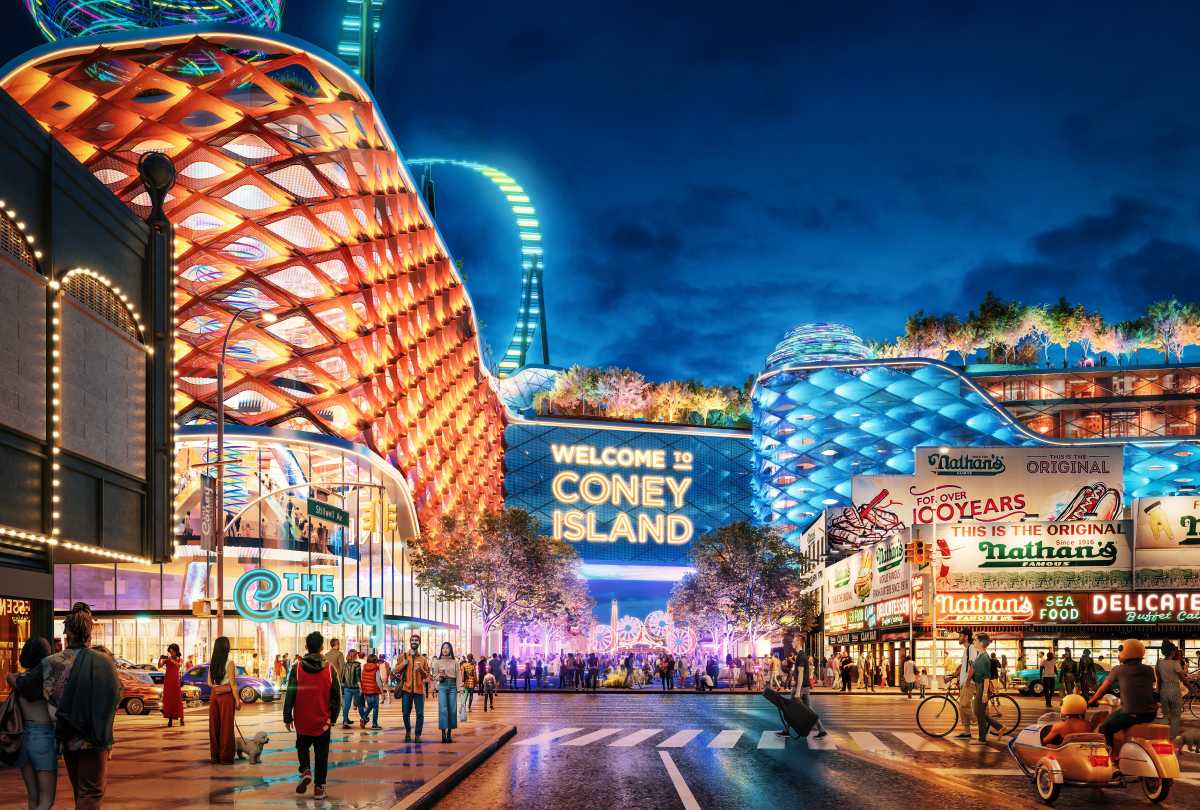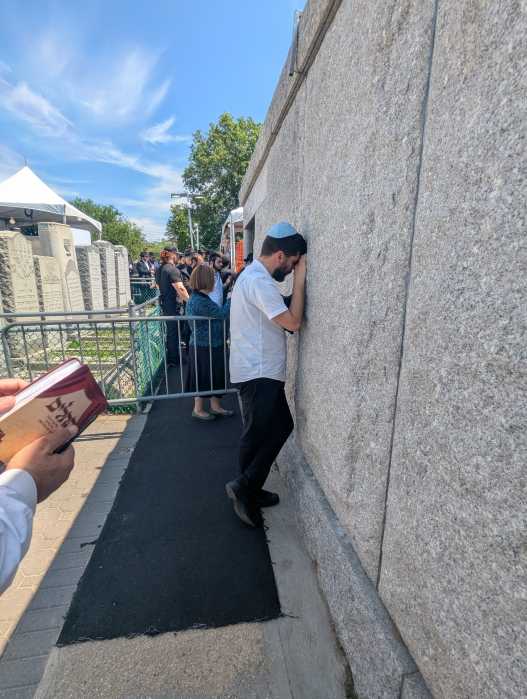
I
Rendering of Howard Hughes Corp.’s plan for the Seaport. Image courtesy of Howard Hughes Corp.
By TERESE LOEB KREUZER AND JOSH ROGERS Originally posted Nov. 20, 2013 and updated Nov. 21 | Howard Hughes Corp. unveiled its plans Tuesday night to build a 50-story hotel and residential tower with a marina at the South Street Seaport. The presentation was met with boos and mocking laughter at a Community Board 1 meeting.
The board’s Seaport Committee had long feared the corporation was planning a large development at the Tin and New Market Buildings. Members of the committee and more than 150 attendees made it clear they did not like the proposal.
Both buildings were part of the old Fulton Fish Market, but only the Tin is in the city’s historic district. The New Market site has long been viewed by the city, Hughes and its predecessors as a prime development site, and it appears the Hughes Corp. would not need city landmarks approval for the tower portion of its plan.
The first detailed information about the Hughes plan surfaced in The New York Times in an article published online Nov. 18.
The next night, Christopher Curry, senior executive vice president for the Dallas-based developer, presented the plan although he said he was not ready to go in to too much detail since it was still preliminary.
Many in the audience held signs saying “Save Our Seaport,” “NYC is not for Sale” and “Don’t Block the Bridge.”
The proposed tower would visually dominate the nearby Brooklyn Bridge and the low-rise, 19th century buildings of the historic Seaport.
“A tall building is something we are proposing because we’re showing you that a tall building is necessary to satisfy a lot of the wants and needs in the community,” Curry said.
This remark was greeted with loud boos.
Gregg Pasquarelli, whose firm, SHoP Architects, designed the shopping mall for Hughes now under construction on Pier 17, outlined the financial pressures that he said led to the inevitability of a high-rise tower in the Seaport.
“We want to be incredibly transparent and we want to show you what we’re thinking about,” Pasquarelli said.
The crowd responded with derisive laughter.
Pasquarelli showed slides of deteriorated pilings under the Tin and New Market buildings.
“Between 80 and 90 percent of the original piles are deteriorated beyond repair where they cannot carry the load,” he said. “About 50 percent of the repaired areas are failing as well. It’s so badly deteriorated that it is not possible to fix it from underneath anymore and it is a huge expense to rebuild these piers.”
He estimated that it would cost $50 million to fix the pilings and another $45 million to repair the Tin Building, which suffered a fire in 1955 and has been empty since the Fulton Fish Market moved to the Bronx in 2005.
“Right now, 95 percent of the façade is actually fiberglass that was replaced in the 1990s to simulate the old, historic building,” he said. “We want to rebuild it with the real tin and make it the original colors.”
Pasquarelli said that additional money would be needed to enhance the esplanade that runs through the Seaport and to build a marina next to the proposed tower. The total cost, he said, would be between $125 million and $150 million.
He and his firm have been working for Hughes and its predecessor at the Seaport, General Growth Properties, for years.
Five years ago, he designed a 500-foot tower for the area. At the time, they proposed restoring the Tin Building and moving it to the east end of Pier 17.
But the plan did not advance far and General Growth ended up filing for bankruptcy.
Under the current plan, which would require Landmarks Preservation Commission approval, the Tin would be elevated to five feet above the flood plain, one story would be added, and the building would be moved around 30 feet closer to the East River.
The building would house a food market under a commitment that Hughes Corp. made earlier this year as part of the approval to demolish and rebuild a new Pier 17 mall. It would be open seven days a week.
The proposed food market would not be run by Robert LaValva, who helped organize the meeting’s large turnout and is the founder of the New Amsterdam Market, held in a temporary, outdoor setting under the F.D.R. Drive.
“The New Amsterdam Market was invited to be a tenant in our Pier 17 market and Mr. LaValva made it very clear that he had no intention of being a tenant of ours,” Curry said. “At this point we have no interest in talking to the New Amsterdam Market about any project.”
The crowd responded with loud boos.
Moments later, LaValva came to the front of the room to huge applause.
“Yes. We were invited to be part of the Pier 17 mall,” he said, “and I did decline that and the reason is very simple. We don’t think that this historic district should be led by a suburban shopping mall.”
The crowd applauded loudly.
LaValva asked how many people were in the room because of the New Amsterdam Market. Many hands went up.
“I’m only asking,” LaValva continued, “because it’s clear that over the years we have grown a citywide audience and a Lower Manhattan audience that understands and recognizes the unique values in the site that is the South Street Seaport.”
He said that the value had to do with the buildings that are there and the placement, uses and height of the buildings.
“We also understand,” he continued, “the significant problems with this site. It needs structural repairs that are huge and are not easy to solve. That being said, what we don’t agree with is the process.”
He said that the Howard Hughes Corporation was acting as though it had an unassailable right to the Tin and New Market Buildings because of its options on these structures, when in fact the options are far from binding.
He asked for “a real master-planning process,” which is something that the community board has also been requesting for a long time.
Addressing Curry, who was standing near him, LaValva said, “I saw the presentation just now and it was terrific but it was all unraveled backwards from the point that you want to get to [a high-rise building] and we have no reason to take everything that was said [based on] your word and frankly, especially on the part of Howard Hughes because you’re not known to be the most honest and honorable of people.”
The crowd applauded.
It’s not yet clear how the project will be viewed by the incoming de Blasio administration, which will play a key role in advancing or nixing the plan.
At the meeting , John Fratta, chairperson of the Seaport Committee, had asked Curry, “In the event that we reject the tall building and that the City of New York miraculously agrees with us, what happens to your plan?”
“I can’t answer that,” Curry replied.
As the discussion concluded, Fratta said, “We have a concern about the towers and even though we’re going to have more dialogue, we want to make our concerns very clear – that at this point we are opposed to any type of tower on that site.”
The C.B. 1 committee unanimously approved a motion opposing a tower on the New Market site.
Fratta said that there would be a town hall meeting some time in January at which members of the public could ask questions and express their concerns about proposed development at the Seaport.
C.B.1 chairperson Catherine McVay Hughes, who is not connected to the corporation, attended the meeting but did not indicate initial support or opposition for the project.
Although she was quoted in the Times article, saying “We understand that in order for it to succeed and provide community amenities, it needs to be economically viable,” she told Downtown Express that her quote pertained to the Pier 17 project and not the latest proposal.
Councilmember Margaret Chin did not attend the meeting but issued a statement expressing “serious concerns about the prospect of a high-rise tower in the South Street Seaport…. I expect the developer to engage in meaningful and constructive dialogue with the community to ensure that any development on this site preserves the unique character of the Seaport. We also want to work toward incorporating much-needed public amenities that reflect what residents want to see in their neighborhood.”
On Wednesday, the Hughes firm issued a press release outlining support from the leaders of business and labor organizations including Robert Douglass, chairperson of the Downtown Alliance, who said, “The South Street Seaport area is in need of continuing revitalization after Superstorm Sandy. The Howard Hughes Corporation’s plan for Pier 17 is an extraordinary piece of that revitalization,” bringing “even more residents, tourists and excitement to Lower Manhattan.”
Gale Brewer, newly elected Manhattan Borough President, attended the C.B. 1 Seaport Committee meeting but did not speak. In March, she was the only City Councilmember to vote against the Hughes firm’s Pier 17 plan.































